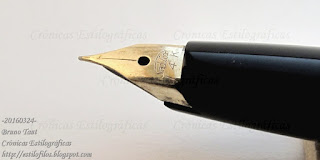To the best of my knowledge, the following pen is an example of the latter.

Figure 1. Two of these pens. Brand unknown, but they implement an interesting filling system. The clips carry two different engravings: "NEW FOUNTAIN PEN" on the red unit; "NEW STEAL" (sic) on the greenish grey.
The pen has no clear indication of the manufacturer, but its construction is remarkable in many ways. But first and foremost because of its filling system.

Figure 2. One of the pens almost completely disassembled: the barrel can be detached from the section. But there is a key part not visible on the picture: inside the bulky brass piece, second from the right, there is another smaller piece that moves along this one.
It is a sac-based system, but with a very original way of pressing (without twisting) the sac. The pen tail can rotate a small angle –about 30°-- with respect to the barrel. Then, a number of small pieces transform that into a movement along the pen axis. The final element is a pressing bar pushed in that longitudinal movement.

Figure 3. These pieces transform the rotation of the back knob (the red celluloid piece on the right) into a movement along the axis of the pen. Inside the central piece there is another smaller one whose notch can be seen through the slit. This internal piece is coupled to the external celluloid knob (see Fig. 4). The central piece is screwed to the barrel.

Figure 4. This is the piece from which the whole filling mechanism is operated. It rotates with respect to the barrel while driving the small piece described on the Figure 3.

Figure 5. On this figure, the whole filling mechanism is assembled outside the barrel. Note how the pressing bard if attached to the set of pieces attached to the actual knob.
As is the case with any sac-based system, twisting the rear knob several times is needed to ensure a good filling of the pen. However, the absence of an internal breathing tube, as is the case in many other systems, hinders the full filling of the sac regardless of the number of twisting moves.
The basic benefit of this system is how secure the filling mechanism is inside the pen. Operating it is, thus, easier than a lever filler, for instance. The negative side is the number of parts required to transfer the rotation into a push onto the sac, plus the need of a good coupling among them.
The construction quality of this filling system is very good—all the pieces, save the external layer of the pan tail and the push bar, are made of brass, and the coupling among them, excellent. The drawback is a tail heavy pen, albeit the total weight of the pen is far from exaggerated at about 20 g.

Figure 6. Steel nib, ebonite feed. The inscription on the nib: "SMOOTH / POSTING / 4 / HARDEST / IRIDIUM / PEN.140".
The pen itself is made of celluloid, and several colors were available. The clip carried different inscriptions –NEW FOUNTAIN PEN and NEW STEAL (sic)--, and can hardly be considered as brand names. Nibs are made of steel, gold plated.
These are their dimensions:
Length closed: 121 mm
Length open: 110 mm
Length posted: 143 mm
Diameter: 11.5 mm
Weight: 20.5 g (dry, no sac)
These are, most likely, postwar pens, but the filling system can be found in some Platon (Nakayama Taiyôdô) pens in the 1930s.
My thanks to Mr. Mochizuki.
Pelikan M800 – Tomiya Tomikei Blue (by Sailor)
Bruno Taut
Nakano, April 13th, 2016
etiquetas: Platon, soluciones técnicas, marca desconocida
Bruno Taut
Nakano, April 13th, 2016
etiquetas: Platon, soluciones técnicas, marca desconocida










































